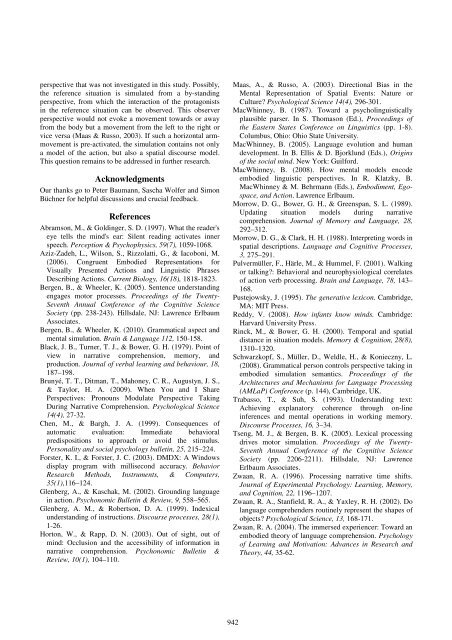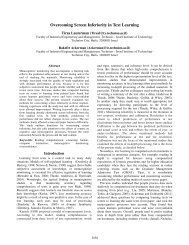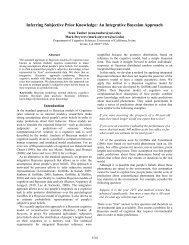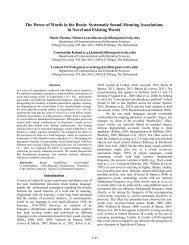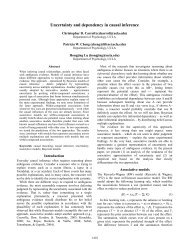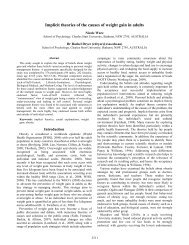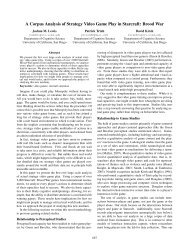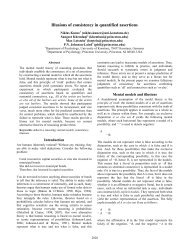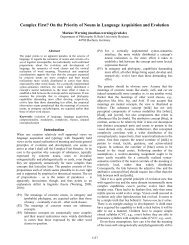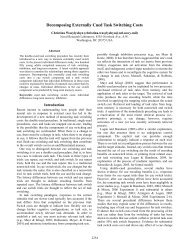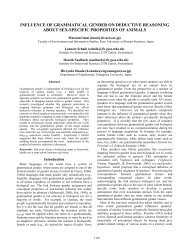Mental Simulation of Spatial Perspective during Sentence ...
Mental Simulation of Spatial Perspective during Sentence ...
Mental Simulation of Spatial Perspective during Sentence ...
Create successful ePaper yourself
Turn your PDF publications into a flip-book with our unique Google optimized e-Paper software.
perspective that was not investigated in this study. Possibly,<br />
the reference situation is simulated from a by-standing<br />
perspective, from which the interaction <strong>of</strong> the protagonists<br />
in the reference situation can be observed. This observer<br />
perspective would not evoke a movement towards or away<br />
from the body but a movement from the left to the right or<br />
vice versa (Maas & Russo, 2003). If such a horizontal armmovement<br />
is pre-activated, the simulation contains not only<br />
a model <strong>of</strong> the action, but also a spatial discourse model.<br />
This question remains to be addressed in further research.<br />
Acknowledgments<br />
Our thanks go to Peter Baumann, Sascha Wolfer and Simon<br />
Büchner for helpful discussions and crucial feedback.<br />
References<br />
Abramson, M., & Goldinger, S. D. (1997). What the reader's<br />
eye tells the mind's ear: Silent reading activates inner<br />
speech. Perception & Psychophysics, 59(7), 1059-1068.<br />
Aziz-Zadeh, L., Wilson, S., Rizzolatti, G., & Iacoboni, M.<br />
(2006). Congruent Embodied Representations for<br />
Visually Presented Actions and Linguistic Phrases<br />
Describing Actions. Current Biology, 16(18), 1818-1823.<br />
Bergen, B., & Wheeler, K. (2005). <strong>Sentence</strong> understanding<br />
engages motor processes. Proceedings <strong>of</strong> the Twenty-<br />
Seventh Annual Conference <strong>of</strong> the Cognitive Science<br />
Society (pp. 238-243). Hillsdale, NJ: Lawrence Erlbaum<br />
Associates.<br />
Bergen, B., & Wheeler, K. (2010). Grammatical aspect and<br />
mental simulation. Brain & Language 112, 150-158.<br />
Black, J. B., Turner, T. J., & Bower, G. H. (1979). Point <strong>of</strong><br />
view in narrative comprehension, memory, and<br />
production. Journal <strong>of</strong> verbal learning and behaviour, 18,<br />
187–198.<br />
Brunyé, T. T., Ditman, T., Mahoney, C. R., Augustyn, J. S.,<br />
& Taylor, H. A. (2009). When You and I Share<br />
<strong>Perspective</strong>s: Pronouns Modulate <strong>Perspective</strong> Taking<br />
During Narrative Comprehension. Psychological Science<br />
14(4), 27-32.<br />
Chen, M., & Bargh, J. A. (1999). Consequences <strong>of</strong><br />
automatic evaluation: Immediate behavioral<br />
predispositions to approach or avoid the stimulus.<br />
Personality and social psychology bulletin, 25, 215–224.<br />
Forster, K. I., & Forster, J. C. (2003). DMDX: A Windows<br />
display program with millisecond accuracy. Behavior<br />
Research Methods, Instruments, & Computers,<br />
35(1),116–124.<br />
Glenberg, A., & Kaschak, M. (2002). Grounding language<br />
in action. Psychonomic Bulletin & Review, 9, 558–565.<br />
Glenberg, A. M., & Robertson, D. A. (1999). Indexical<br />
understanding <strong>of</strong> instructions. Discourse processes, 28(1),<br />
1-26.<br />
Horton, W., & Rapp, D. N. (2003). Out <strong>of</strong> sight, out <strong>of</strong><br />
mind: Occlusion and the accessibility <strong>of</strong> information in<br />
narrative comprehension. Psychonomic Bulletin &<br />
Review, 10(1), 104–110.<br />
Maas, A., & Russo, A. (2003). Directional Bias in the<br />
<strong>Mental</strong> Representation <strong>of</strong> <strong>Spatial</strong> Events: Nature or<br />
Culture? Psychological Science 14(4), 296-301.<br />
MacWhinney, B. (1987). Toward a psycholinguistically<br />
plausible parser. In S. Thomason (Ed.), Proceedings <strong>of</strong><br />
the Eastern States Conference on Linguistics (pp. 1-8).<br />
Columbus, Ohio: Ohio State University.<br />
MacWhinney, B. (2005). Language evolution and human<br />
development. In B. Ellis & D. Bjorklund (Eds.), Origins<br />
<strong>of</strong> the social mind. New York: Guilford.<br />
MacWhinney, B. (2008). How mental models encode<br />
embodied linguistic perspectives. In R. Klatzky, B.<br />
MacWhinney & M. Behrmann (Eds.), Embodiment, Egospace,<br />
and Action. Lawrence Erlbaum.<br />
Morrow, D. G., Bower, G. H., & Greenspan, S. L. (1989).<br />
Updating situation models <strong>during</strong> narrative<br />
comprehension. Journal <strong>of</strong> Memory and Language, 28,<br />
292–312.<br />
Morrow, D. G., & Clark, H. H. (1988). Interpreting words in<br />
spatial descriptions. Language and Cognitive Processes,<br />
3, 275–291.<br />
Pulvermüller, F., Härle, M., & Hummel, F. (2001). Walking<br />
or talking?: Behavioral and neurophysiological correlates<br />
<strong>of</strong> action verb processing. Brain and Language, 78, 143–<br />
168.<br />
Pustejowsky, J. (1995). The generative lexicon. Cambridge,<br />
MA: MIT Press.<br />
Reddy, V. (2008). How infants know minds. Cambridge:<br />
Harvard University Press.<br />
Rinck, M., & Bower, G. H. (2000). Temporal and spatial<br />
distance in situation models. Memory & Cognition, 28(8),<br />
1310–1320.<br />
Schwarzkopf, S., Müller, D., Weldle, H., & Konieczny, L.<br />
(2008). Grammatical person controls perspective taking in<br />
embodied simulation semantics. Proceedings <strong>of</strong> the<br />
Architectures and Mechanisms for Language Processing<br />
(AMLaP) Conference (p. 144), Cambridge, UK.<br />
Trabasso, T., & Suh, S. (1993). Understanding text:<br />
Achieving explanatory coherence through on-line<br />
inferences and mental operations in working memory.<br />
Discourse Processes, 16, 3–34.<br />
Tseng, M. J., & Bergen, B. K. (2005). Lexical processing<br />
drives motor simulation. Proceedings <strong>of</strong> the Twenty-<br />
Seventh Annual Conference <strong>of</strong> the Cognitive Science<br />
Society (pp. 2206-2211). Hillsdale, NJ: Lawrence<br />
Erlbaum Associates.<br />
Zwaan, R. A. (1996). Processing narrative time shifts.<br />
Journal <strong>of</strong> Experimental Psychology: Learning, Memory,<br />
and Cognition, 22, 1196–1207.<br />
Zwaan, R. A., Stanfield, R. A., & Yaxley, R. H. (2002). Do<br />
language comprehenders routinely represent the shapes <strong>of</strong><br />
objects? Psychological Science, 13, 168-171.<br />
Zwaan, R. A. (2004). The immersed experiencer: Toward an<br />
embodied theory <strong>of</strong> language comprehension. Psychology<br />
<strong>of</strong> Learning and Motivation: Advances in Research and<br />
Theory, 44, 35-62.<br />
942


